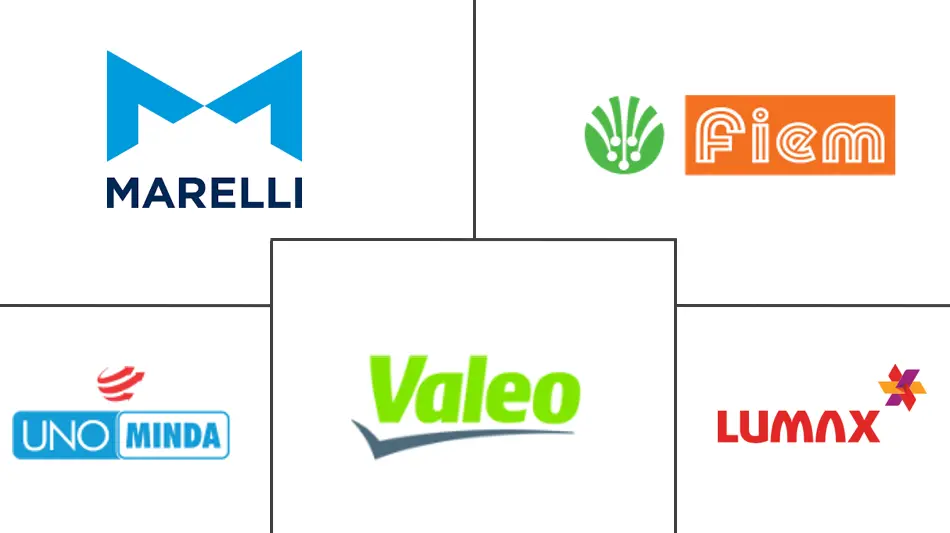India Automotive LED Lighting Market Size and Share
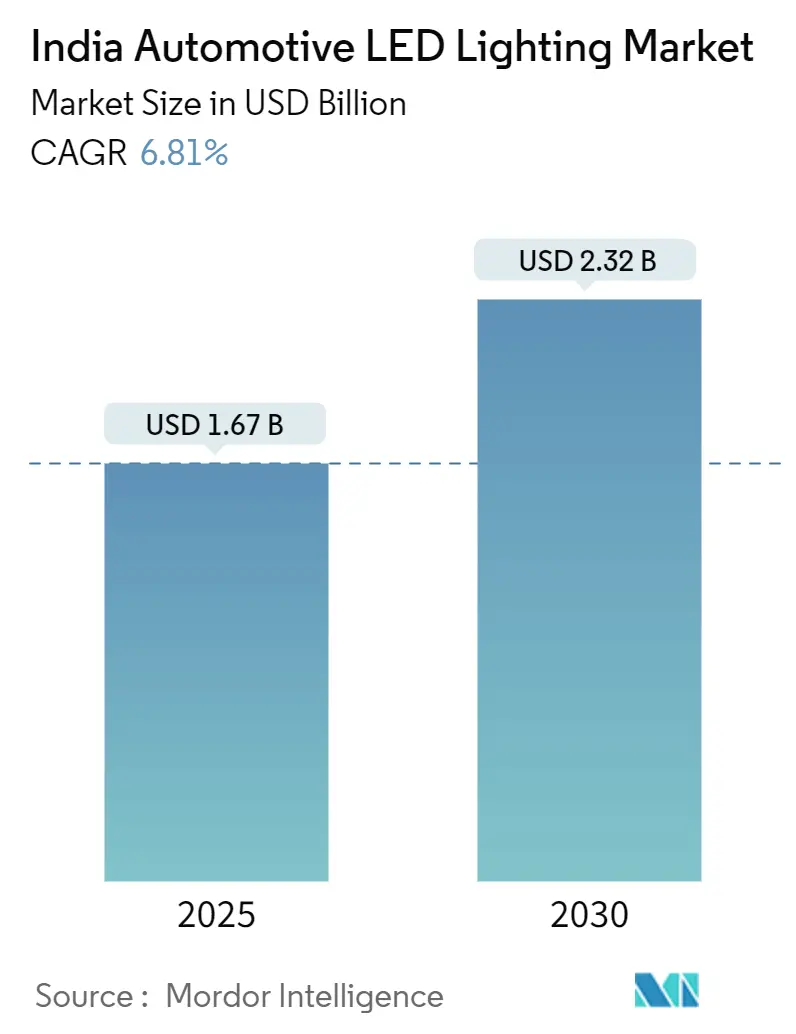
India Automotive LED Lighting Market Analysis by Mordor Intelligence
The India automotive LED lighting market size stands at USD 1.67 billion in 2025 and is projected to reach USD 2.32 billion by 2030, translating into a 6.81% CAGR. Momentum stems from strict lighting regulations, rising electric-vehicle (EV) output, and Production-Linked Incentive (PLI) support that together accelerate the replacement of halogen and xenon systems with advanced LEDs. OEMs are migrating entire model portfolios to all-LED headlamp architectures, semiconductor prices continue to fall, and domestic capacity additions in Tamil Nadu and Haryana improve component availability. Passenger-car premiumization and SUV popularity boost adaptive headlamp demand, while two-wheeler automatic headlamp-on (AHO) mandates ensure continual LED penetration into the world’s largest powered-two-wheeler production base. Aftermarket styling in Delhi NCR, Mumbai, and Pune, coupled with a 90,000-unit EV parc that is forecast to surpass 1 million vehicles by FY29, adds further lift for the India automotive LED lighting market.
Key Report Takeaways
- By sales channel, the OEM segment captured 84.54% of the India automotive LED lighting market share in 2024, whereas the aftermarket is advancing at a 7.66% CAGR through 2030.
- By vehicle type, passenger cars commanded 69.35% of the India automotive LED lighting market size in 2024 and are projected to expand at a 10.02% CAGR to 2030.
- By installation, new-vehicle fitments held 64.34% share of the India automotive LED lighting market size in 2024; retrofit installations lead growth at a 7.73% CAGR through 2030.
- By application, exterior lighting accounted for 79.68% of the India automotive LED lighting market size in 2024, while interior lighting is advancing at a 7.98% CAGR through 2030.
India Automotive LED Lighting Market Trends and Insights
Drivers Impact Analysis
| Driver | (~) % Impact on CAGR Forecast | Geographic Relevance | Impact Timeline |
|---|---|---|---|
| OEM shift to all-LED headlamp platforms | +1.2% | National, automotive hubs | Medium term (2-4 years) |
| Two-wheeler AHO & DRL mandates | +0.9% | National; urban compliance strongest | Short term (≤ 2 years) |
| EV-specific energy-efficiency needs | +0.8% | National; EV clusters | Medium term (2-4 years) |
| Falling LED package prices & new domestic fabs | +0.7% | Tamil Nadu, Haryana | Long term (≥ 4 years) |
| PLI incentives for advanced lighting | +0.6% | Approved clusters | Long term (≥ 4 years) |
| Aftermarket styling demand in Tier-1/2 cities | +0.5% | Delhi NCR, Mumbai, Pune | Short term (≤ 2 years) |
| Source: Mordor Intelligence | |||
OEM shift to all-LED headlamp platforms across mid-range models
Passenger-vehicle production touched 4.2 million units in FY24 and is forecast to breach 5.7 million units by FY29, giving LED suppliers a broadening base for platform-level integration. [1]Hyundai Motor India Ltd., “Industry Report on the Passenger Vehicle Industry in India – Update,” CRISIL, hyundai.com SUV share more than doubled to 51%, intensifying brand competition centered on signature lamp designs. Adaptive-matrix and pixel technologies that once defined luxury trims now reach INR 15–20 lakh price bands as semiconductor and optical costs fall. Localized PCB and lens assembly under the PLI umbrella improve cost parity with halogen/xenon systems. Automakers receive both styling freedom and lower warranty risk because LEDs withstand vibration better than filament bulbs.
Two-wheeler AHO & DRL mandates accelerating LED penetration
India manufactures 21.2 million two-wheelers per year, all of which must now leave the factory with AHO capability. Continuous-illumination duty cycles strain incandescent filaments, prompting OEMs to select LEDs for thermal, power, and life-cycle advantages. Urban enforcement in Gujarat and Maharashtra has removed many non-compliant retrofit kits from the road, steering riders toward certified OEM or IS-certified aftermarket units. The rule is also spurring innovation in compact DRL modules that slot into existing housings, lowering redesign costs for mass-market scooters and motorcycles.
EV-specific energy-efficiency requirements
EV power budgets allocate less than 3% of pack capacity to lighting, forcing OEMs to harvest every watt. LED efficacy nearing 180 lm/W, paired with sophisticated driver ICs, keeps consumption minimal. Thermal loads integrate with battery coolant loops, which is impossible for halogen systems. Mahindra’s SkyViera panoramic roof demonstrates how EV architectures encourage new ambient-lighting canvases that double as brand cues. Commercial EV makers employ low-glare LED daytime signaling to improve pedestrian awareness in congested delivery zones.
Falling LED package prices and domestic capacity expansion
Joint ventures such as Dixon-Signify and Lumax’s Chakan plant expansion collectively add more than 120 million automotive-grade LEDs of annual capacity. Scale economies trimmed average LED package costs by 14% in 2024 and are on pace for a further 10% decline by 2027. [2]UNO Minda Ltd., “Quarterly Financial Results Q2 FY25,” UNO Minda, unominda.com Domestic sourcing lifts localization levels above the 50% Phased-Manufacturing threshold, unlocking higher PLI disbursements. Reduced import reliance also buffers the India automotive LED lighting market against currency swings.
Restraints Impact Analysis
| Restraint | (~) % Impact on CAGR Forecast | Geographic Relevance | Impact Timeline |
|---|---|---|---|
| Regulatory push-back on unauthorized high-intensity retrofits | −0.4% | Gujarat, Delhi NCR | Short term (≤ 2 years) |
| Volatile rare-earth/semiconductor supply for driver ICs | −0.6% | National; import-reliant firms | Medium term (2-4 years) |
| High 50% localization threshold squeezes smaller players | −0.3% | Tier-2, Tier-3 suppliers | Long term (≥ 4 years) |
| Persistently price-sensitive entry-level vehicle mix | −0.5% | Rural and semi-urban | Long term (≥ 4 years) |
| Source: Mordor Intelligence | |||
Regulatory push-back on unauthorized high-intensity retrofit kits
Traffic authorities confiscated more than 6,000 non-compliant lamps in Ahmedabad during 2024, demonstrating rising political focus on glare-related accidents. New Central Motor Vehicles Rules draft language will require type-approved retrofit systems, raising compliance costs for gray-market importers. Legitimate aftermarket firms can differentiate via Bureau of Indian Standards labeling and photometric test reports.
Volatile rare-earth/semiconductor supply for LED drivers
China controls about 85% of global rare-earth output used in phosphors and power inductor alloys. [3] Ministry of External Affairs, “Joint Statement During the Visit of Prime Minister to China,” Government of India, mea.gov.in Trade tensions or pandemic-scale factory shutdowns can spike prices and lengthen lead times past 20 weeks. Smaller Indian Tier-3 assemblers lack hedging capacity and may lose OEM contracts if they cannot guarantee continuity. PLI-funded fab proposals are promising but will take several years before meaningful volumes support the India automotive LED lighting market.
Segment Analysis
By Sales Channel: Aftermarket momentum challenges OEM dominance
OEM deliveries represented 84.54% of 2024 revenue, yet retrofit revenues are projected to expand at a 7.66% CAGR to 2030. OEM capture rests on tightly integrated systems linked to ADAS sensors and body-control modules that small workshops cannot easily duplicate. Varroc’s USD 1.32 billion order book underscores growing platform-level outsourcing.
The aftermarket still finds fertile ground in India’s 40 million-plus halogen vehicle parc, where a color-tunable LED bulb kit serves as an inexpensive style upgrade. Continuous regulatory clampdowns encourage formalization; certified retrofit brands now bundle warranty-safe harnesses and CANbus decoders that minimize error codes.
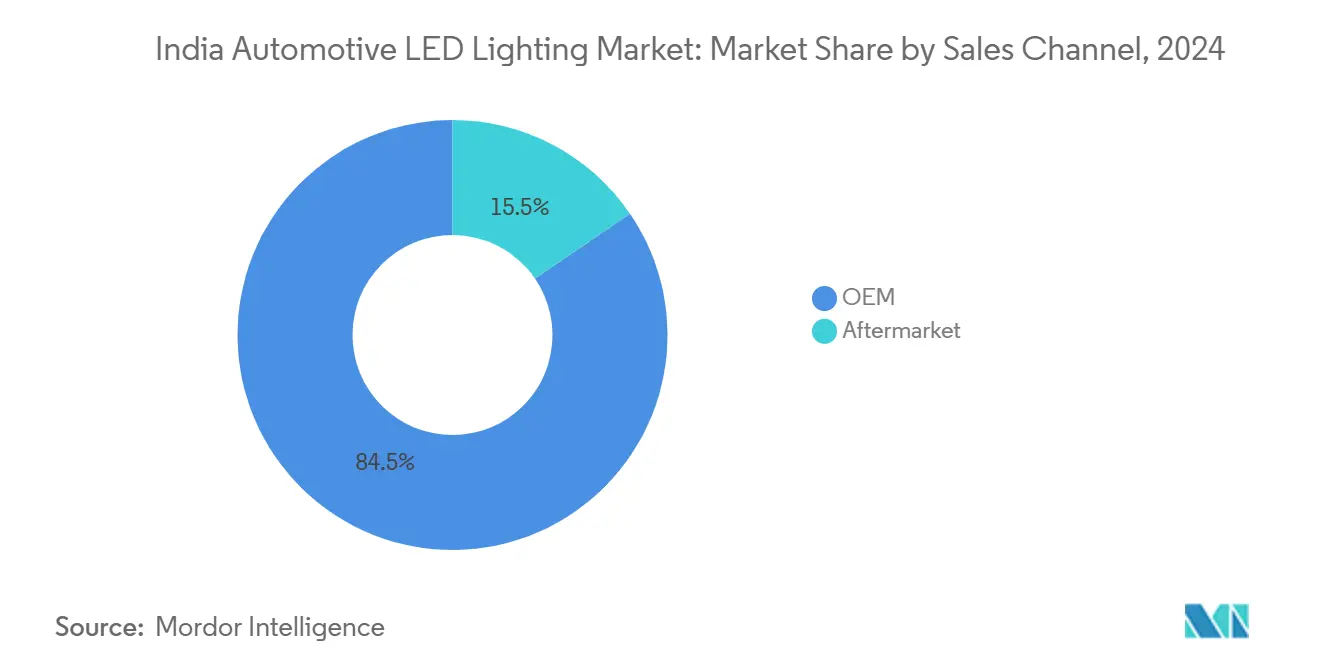
By Vehicle Type: Passenger-car electrification drives LED integration
Passenger cars contributed 69.35% of the 2024 sector revenue and are expected to post a 10.02% CAGR, driven by SUVs, which now account for 51% of passenger-vehicle production. The designers of these vehicles rely on signature DRLs for showroom differentiation. Automakers favor adaptive-matrix headlamps because their glare-free high beam supports 2026 ADAS mandates without incurring energy-consumption penalties, thereby enhancing the India automotive LED lighting market, particularly for premium trims.
Two-wheelers remain structurally important, thanks to an annual production of 21.2 million and the automatic headlamp-on rule. However, price sensitivity outside of metros constrains wholesale LED penetration, especially for entry-level motorcycles. Light commercial vans that serve e-commerce routes adopt LEDs for range extension and lower bulb-replacement downtime, while heavy trucks migrate more slowly, waiting for the domestic 24-V driver IC supply that PLI-funded fabs promise to deliver by 2028.
By Installation Type: Retrofit growth reflects urban consumer preferences
New-vehicle fitments secured 64.34% of 2024 spending because OEMs bundle LEDs with warranty coverage and integrated diagnostics, locking in Tier-1 suppliers that already meet 50% localization thresholds. Those contracts stabilize the Indian automotive LED lighting market size for factory installations, even when raw material prices rise, as pass-through clauses protect margins.
The retrofit value is forecasted to outpace at a 7.73% CAGR through 2030 as smartphone-controlled halo kits and sequential indicators gain social media traction, especially among car owners aged 18-30 in Delhi NCR and Pune. Tighter enforcement against glare-heavy imports nudges hobbyists toward BIS-approved products, a shift expected to lift the retrofit India automotive LED lighting market share inside organized retail while squeezing gray-market e-commerce sellers.
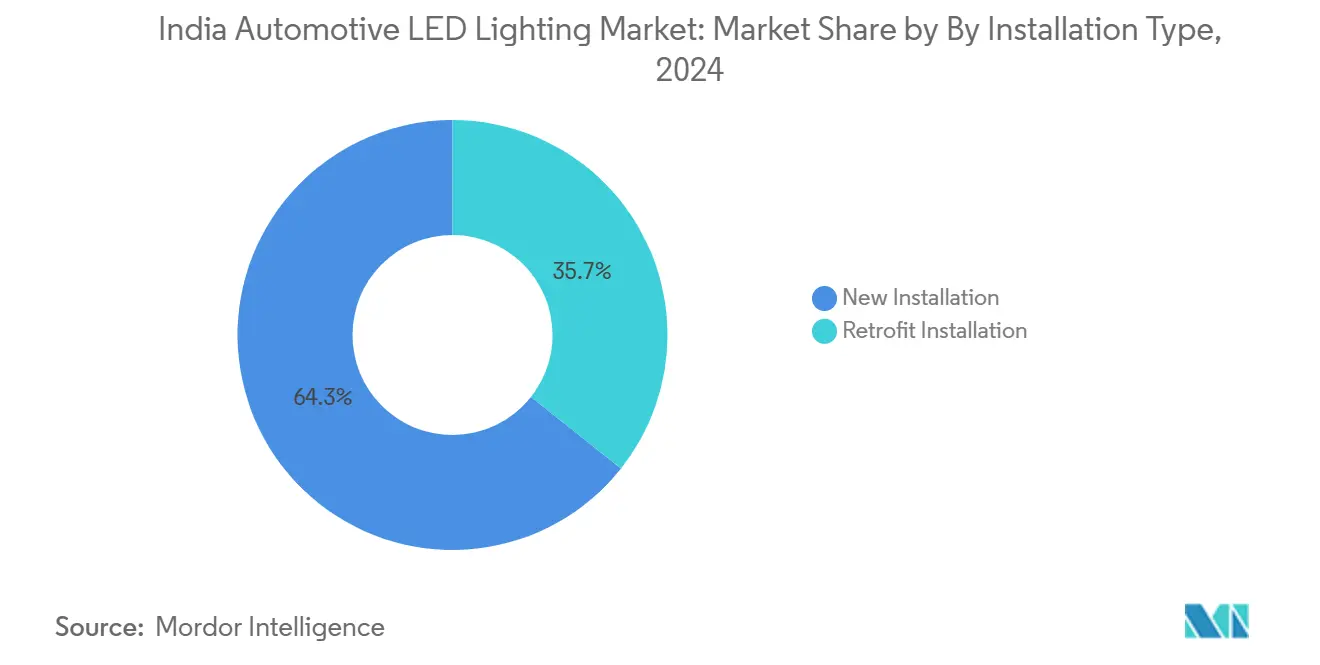
By Application: Interior lighting innovation challenges exterior dominance
Exterior systems accounted for 79.68% of the 2024 market value, as mandatory DRLs, high-mount stop lamps, and turn indicators create non-discretionary demand that is directly tied to vehicle homologation tests. Headlamps, moving rapidly toward adaptive beam patterns, capture the largest slice of the Indian automotive LED lighting market, especially as SUV front-end real estate expands for brand-specific light signatures.
Interior ambient strips, projected foot-wells, and panoramic-roof light guides now post a 7.98% CAGR because OEMs can add perceived luxury at low incremental cost, often leveraging the same LIN-bus harness that powers cockpit electronics. As micro-LED prices fall, dashboards will integrate 360-degree optical guides that double as haptic feedback surfaces, a feature set likely to boost the interior segment’s India automotive LED lighting market share once mid-range models adopt the technology after 2027.
Geography Analysis
Southern India remains the production nucleus for the India automotive LED lighting market, with Chennai manufacturing roughly 35% of national vehicle output in FY24. Proximity to Hyundai, Renault-Nissan, and TVS Motors anchors a sophisticated supplier ecosystem that now includes multiple SMT lines dedicated to automotive-grade LEDs. Western clusters around Pune and Chakan specialize in advanced headlamp modules; Lumax expanded its Chakan facility in August 2024, leveraging PLI subsidies for optical-robotic assembly cells that cut takt time by 18%. Northern regions such as Haryana cater to Maruti Suzuki and Honda Cars, consuming high volumes of commodity DRLs and tail-lamps.
Urban aftermarket demand is strongest in Delhi NCR and Mumbai, where younger demographics and higher disposable income prioritize styling. These cities also host the strictest enforcement against glare-inducing retrofits, favoring certified brands. Gujarat’s state police introduced handheld luminance meters in 2024, a move expected to ripple into other jurisdictions and shift sales toward compliant suppliers.
Eastern India benefits indirectly from the PM E-Drive scheme’s allocation of USD 2.4 billion for EV adoption, which includes charging-station lighting. LED pole-tops and illuminated signage around fast chargers create spillover volume for lighting OEMs. Northeastern states receive similar subsidies, tempting Tier-2 suppliers to set up micro-assembly sites that cut freight costs and claim regional tax holidays.
Competitive Landscape
Innovation and Localization Key to Success
The India automotive LED lighting market displays moderate concentration, with the top five suppliers holding about 48% revenue in 2024. Koito remains the technological pacesetter, supplying adaptive-matrix systems to Maruti’s Fronx and Hyundai’s Alcazar. HELLA leverages its global optics portfolio to win premium SUV programs, while Marelli meshes lighting with its cabin digitization solutions. Domestic champions Lumax and UNO Minda respond with aggressive capacity additions and co-development agreements that secure localization credits.
Intellectual-property intensity favors vertically integrated firms that can deliver optics, drivers, and thermal modules under one roof. Patent filings for silicon-carbide driver ICs and holographic lenses grew 16% year over year, signaling rapid innovation. Partnerships blossom: Motherson-Marelli focuses on software-defined lamp control, Dixon-Signify targets low-cost EV headlamps, and Varroc allies with Seoul Semiconductor for high-efficacy CSP LEDs.
Price competition remains fierce in commodity DRLs, but adaptive beam systems command healthy margins owing to their algorithmic complexity. Suppliers target embedded LiDAR and camera synergy that aligns illumination with sensor line-of-sight. Over-the-air updatable lighting profiles create future recurring-revenue pathways, challenging traditional one-time hardware sales.
India Automotive LED Lighting Industry Leaders
Fiem Industries Ltd.
Marelli Holdings Co., Ltd.
Uno Minda Limited
Lumax Industries Limited
Valeo SA
- *Disclaimer: Major Players sorted in no particular order
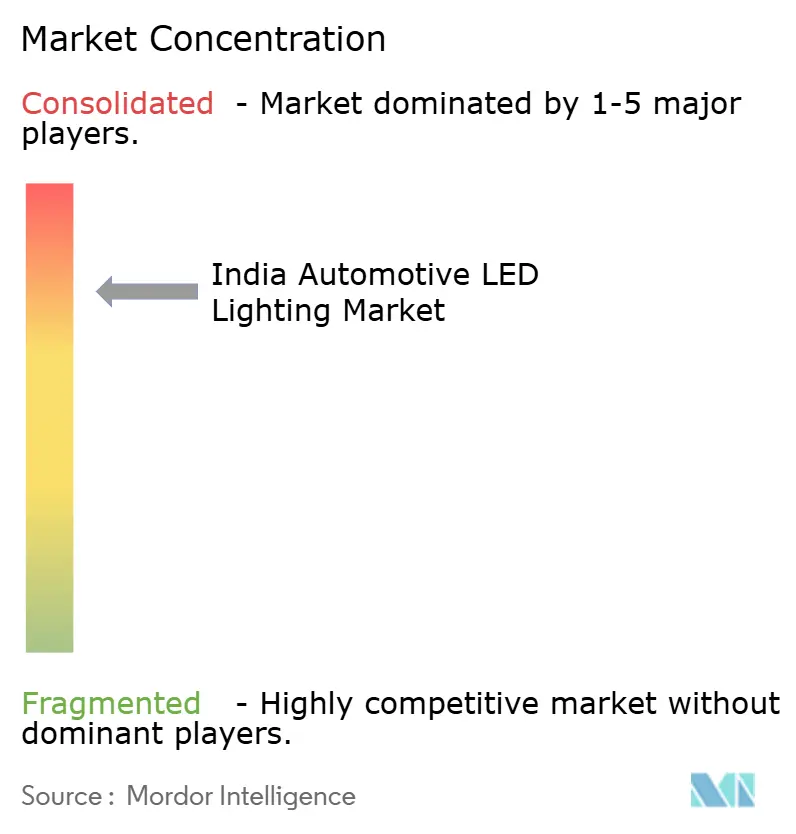
Recent Industry Developments
- September 2025: Kuraray’s SkyViera ambient-lighting film adopted in Mahindra BE 6 and XEV 9e EV roof modules.
- March 2025: HARMAN unveiled Ready Vision QVUE 5,000-nit windshield display at MWC Barcelona.
- January 2025: BYD India expanded EV dealerships to 40, previewing SEALION 7 SUV with full-LED exterior suite.
- September 2024: Varroc logged USD 1.32 billion order book, up 32%, led by LED contracts.
India Automotive LED Lighting Market Report Scope
Daytime Running Lights (DRL), Directional Signal Lights, Headlights, Reverse Light, Stop Light, Tail Light, Others are covered as segments by Automotive Utility Lighting. 2 Wheelers, Commercial Vehicles, Passenger Cars are covered as segments by Automotive Vehicle Lighting.| OEM |
| Aftermarket |
| Passenger Cars |
| Light Commercial Vehicles |
| Heavy Commercial Vehicles |
| Two-Wheelers |
| New Installation |
| Retrofit Installation |
| Exterior Lighting | Headlamps |
| Daytime Running Lights | |
| Taillights | |
| Fog Lamps | |
| Turn Signals | |
| Other Exterior Lightings | |
| Interior Lighting | Dome and Map Lights |
| Ambient Lighting | |
| Instrument Cluster and Infotainment Backlighting | |
| Others Interior Lightings |
| By Sales Channel | OEM | |
| Aftermarket | ||
| By Vehicle Type | Passenger Cars | |
| Light Commercial Vehicles | ||
| Heavy Commercial Vehicles | ||
| Two-Wheelers | ||
| By Installation Type | New Installation | |
| Retrofit Installation | ||
| By Application | Exterior Lighting | Headlamps |
| Daytime Running Lights | ||
| Taillights | ||
| Fog Lamps | ||
| Turn Signals | ||
| Other Exterior Lightings | ||
| Interior Lighting | Dome and Map Lights | |
| Ambient Lighting | ||
| Instrument Cluster and Infotainment Backlighting | ||
| Others Interior Lightings | ||
Market Definition
- INDOOR LIGHTING - It incorporates all LED based lamps and fixtures/luminaire that are used to illuminate indoor section of residential, commercial, industrial buildings and agricultural lighting. LED offers efficient brightness with higher durability in comparison to other lighting technology.
- OUTDOOR LIGHTING - It incorporates the LED lighting fixtures that is used for illumination for exterior/outdoor illumination. For instance, LED lighting fixtures used to illuminate streets and highways, transport hubs, stadiums and other public places such as parking spaces.
- AUTOMOTIVE LIGHTING - It refers to the lighting fixtures installed for illumination and signaling purposes. It is used in both exterior and interior lighting of the vehicle. Headlamps, fog lamp, daytime running light (DRLs) are examples of exterior light whereas cabin light are interior lights.
- END USER - It refers to the end use application area where the LED fixture will be installed. For instance, in terms of indoor lighting, we have residential, commercial and industrial as end user category. For automotive lighting, primary end user considered are automotive manufacturers and aftermarket sale
| Keyword | Definition |
|---|---|
| Lumen | Lumen is a unit of luminous flux in the International System of Units that is equal to the amount of light given out through a solid angle by a source of one-candela intensity radiating equally in all directions. |
| Footcandle | A foot-candle (or foot-candle, fc, lm/ft2, or ft-c) is a measurement of light intensity. One foot-candle is defined as enough light to saturate a one-foot square with one lumen of light. |
| Colour Rendering Index (CRI) | Color Rendering Index (CRI) is a measurement of how natural colors render under an artificial white light source when compared with sunlight. The index is measured from 0-100, with a perfect 100 indicating that colors of objects under the light source appear the same as they would under natural sunlight. |
| Luminous flux | Luminous flux is a measure of the power of visible light produced by a light source or light fitting. It is measured in lumens (lm). |
| Annual Energy Cost | Annual Energy Cost means the average daily energy consumption multiplied by 365 (days per year), expressed in kilowatt hour per year (kWh/a). |
| Constant voltage drivers | Constant voltage drivers are designed for a single direct current (DC) output voltage. Most common constant voltage drivers (or Power Supplies) are 12VDC or 24VDC. An LED light that is rated for constant voltage usually specifies the amount of input voltage it needs to operate correctly. |
| Constant Current Driver | Constant current LED drivers are designed for a designated range of output voltages and a fixed output current (mA). LEDs that are rated to operate on a constant current driver require a designated supply of current usually specified in milliamps (mA) or amps (A). These drivers vary the voltage along an electronic circuit which allows current to remain constant throughout the LED system. |
| Minimum Energy Performance Standards (MEPS) | Minimum Energy Performance Standards specify the minimum level of energy performance that appliances and equipment must meet or exceed before they can supply or used for commercial purposes. |
| Luminous Efficacy | Luminous efficacy is a measurement commonly used in the lighting industry that indicates the ability of a light source to emit visible light using a given amount of power. |
| Solid State Lighting | Solid-state lighting (SSL) is a type of lighting that uses semiconductor light-emitting diodes (LEDs), organic light-emitting diodes (OLED), or polymer light-emitting diodes (PLED) as sources of illumination rather than electrical filaments, plasma (used in arc lamps such as fluorescent lamps), or gas. |
| Rated Lamp Life | Lamp life, also referred to as rated life, is the time in hours a lamp will last before a percentage of lamps will burn out. |
| Color Temperature | Colour temperature is a scale that measures how ‘warm’ (yellow) or ‘cool’ (blue) the light from a particular source is. It is measured in degrees of the Kelvin scale (abbreviated to K), and the higher the number, the ‘cooler’ the light. The lower the ‘K’ number, the ‘warmer’ the light. |
| Ingress Protection rating (IP rating) | The IP (Ingress Protection) rating of a bulb or light fixture declares the level of protection it has against dirt and water. |
| Fidelity Index | The general colour fidelity index, Rf, represents how closely the colour appearances of the entire sample set are reproduced (rendered) on average by a test light as compared to those under a reference illuminant. |
| Gamut Index | The gamut area is defined as “the area enclosed by a set of test color samples illuminated by a light source, in a two-dimensional chromaticity diagram or a plane of color space.”1 Within a defined color space, a “gamut” describes the subset of colors that can be perceived under specific lighting conditions. |
| Binning | In the lighting industry, the act of "binning" of LEDs is the process of sorting LEDs by certain characteristics, such as color, voltage, and brightness. |
| Accent lighting | Accent lighting, also called highlighting, emphasizes objects by focusing light directly on them. Accent lighting is used inside and outside the home to feature locations such as an entrance or to create dramatic effects. |
| Dimmable driver | A dimming driver has two functions: As a driver, it converts the 230V AC mains input to a low voltage DC output. As a dimmer, it reduces the amount of electrical energy flowing to the LEDs, thereby causing them to dim. |
| Flicker | Flicker is the repeated and frequent variation in the output of a light source over time. |
| Fluorescent | A property of materials defined as the ability to emit light after absorbing electromagnetic radiation such as visible or UV light. |
| Candela | The candela is the unit of luminous intensity in the International System of Units. It measures the light output per unit solid angle emitted from a light source in a specific direction. |
| LUX | Lux is used to measure the amount of light output in a given area - one lux is equal to one lumen per square meter. It enables us to measure the total "amount" of visible light present and the intensity of the illumination on a surface. |
| Uniformity (U0) | The uniformity of lighting has significant effects on visual performance in both indoor and outdoor areas. Uniformity (represented as U0) value can be found by dividing the minimum brightness (Emin) resulting from calculations according to the current lighting order, to the average brightness value (Eavg). |
| Visible Light Spectrum | The visible light spectrum is the segment of the electromagnetic spectrum that the human eye can view. More simply, this range of wavelengths is called visible light. Typically, the human eye can detect wavelengths from 380 to 700 nanometers. |
| Ambient Temperature | Ambient Temperature is the temperature of the air surrounding an electrical enclosure. |
| Current-controlled dimming control | Current-controlled dimming controls LED brightness by varying the applied current using a 0-10V dimmer. Current-controlled dimming is smooth and HD-video friendly. It can only dim to a minimum of 5% of light output. |
| Design Light Consortium | It is a partnership of energy efficiency stakeholders in the United States and Canada to “promote quality, performance and energy efficient lighting solutions for the commercial sector”. |
| Pulse Width Modulation | Pulse-width modulation, or pulse-duration modulation, is a method of controlling the average power delivered by an electrical signal. |
| Surface Mounted Device | A surface mount device (SMD) is an electronic device whose components are mounted or placed directly on the surface of a printed circuit board. |
| Alternating Current | Alternating current is an electric current which periodically reverses direction and changes its magnitude continuously with time, in contrast to direct current, which flows only in one direction. |
| Direct Current | Direct current (DC) is an electric current that is uni-directional, so the flow of charge is always in the same direction. |
| Beam Angle | Beam angle (also called beam spread) is a measure of how light is distributed. On any plane perpendicular to the centerline of the light, the beam angle is the angle between two rays where the light intensity is 50% of the maximum light intensity. |
| LED Based Solar High Mast Lighting Systems | A Solar LED High Mast Light is a raised source of High illumination lights (6~8 lights) and with high intensity on the middle of major junctions (Ring roads, Outer Ring roads), turned on or lit automatically in the absence of light (at specified timings or at periodic times, every night). |
| Surface Mounted Diode (SMD) LEDs | A surface mount diode is a type that emits light and is flat mounted and soldered onto a circuit board. |
| Chip on Board (COB) LEDs | A COB LED is basically multiple LED chips (usually 9 or more) glued directly onto a substrate by the manufacturer to form a single module. |
| Dual In-Line Package (DIP) LEDs | A dual in-line package (DIP or DIL) is an electronic component package with a rectangular case and two parallel rows of electrical connector pins. |
| Graphene LED Lights | A graphene LED light bulb is simply an LED light bulb where the filament has been coated in graphene. A graphene LED bulb is reported to be 10% more efficient than regular LED light bulbs and they are cheaper to manufacture and buy. |
| LED Corn Bulbs | LED Corn lights are designed as an energy efficient alternative to high intensity discharge (HID) and SON lamps. It uses a large number of LEDs on a metal structure to provide sufficient light. This arrangement of LEDs looks a lot like a corn cob, hence the name "corn light". |
| Per Capita Income | Per capita income or total income measures the average income earned per person in a given area in a specified year. It is calculated by dividing the area's total income by its total population. Per capita income is national income divided by population size. |
| Charging Stations | A charging station, also known as a charging station or electric vehicle utility, is a power supply that provides electrical energy for charging plug-in electric vehicles. |
| Headlight | A headlight is a light that is mounted on the front of a car and illuminates the road in front of it. Low beam and high beam LED headlights are additional categories for these LED headlights. |
| Day Time Running Light (DRLs) | A daytime running lamp is a white, yellow, or amber lighting device mounted on the front of a road-going motor vehicle or bicycle. |
| Directional Signal Light | Directional signal lights are the front and rear lights on an automobile that flash to show the direction of a turn. |
| Stop Light | A red light that is mounted to the back of a car and turns on when the brakes are used to show that the car is stopped. |
| Reverse Light | The reverse light is at the back of the vehicle to indicate its backward motion. |
| Tail Light | A red light that can be seen in the dark is mounted on the rear of a road vehicle. Stop, reverse, and directional signal lights are all part of it. |
| Fog Light | Bright lights in automobiles used to increase visibility on the road in foggy conditions or to warn other drivers of the presence of the vehicle. |
| Passenger Vehicle | A passenger vehicle is a road vehicle, other than a moped or a motorcycle, intended for the transportation of people and designed for up to 8 to 9 seats. |
| Commercial Vehicle | A commercial vehicle (Bus, Truck, Van) is any type of motor vehicle used to transport goods or pay passengers. |
| Two Wheelers (2W) | A two-wheeler is a vehicle that runs on two wheels. |
| Streets & Roadways | Both roads and streets refer to hard, flat surfaces on the ground on which vehicles, people, and animals can travel. Since streetways are usually in cities and towns, they often have houses and buildings on both sides. The roadway is in the countryside and sometimes passes through forests and fields |
| Horticulture Lighting | Horticulture is the science and art of sustainably growing, producing, marketing and using high quality, intensively cultivated food and ornamental plants. |
Research Methodology
Mordor Intelligence has followed the following methodology in all our data center reports.
- Step 1: Raw Data Collection: To understand the market, initially, all crtical data points were identified. Critical information about countries and regions of interest including Per-capita Income, Population, Automotive Production, Interest rate on Auto-Loans, Number of Automobiles on Road, Total LED Import, Lighting Electricity Consumption among others were recorded or estimated based on internal calculations.
- Step 2: Identify Key Variables: To build a robust forecasting model, key variables such as Number of Households, Automotive Production, Road Networks among others were identified. Through an iterative process, the variables required for the market forecast were set, and the model was built using these variables.
- Step 3: Build a Market Model: Based on data and critical industry trend data (variables), including LED pricing, LED penetration rate, and project macro and micor economic factors were utilized for building the market forecasting.
- Step 4: Validate and Finalize: In this crucial step, all market numbers and variables derived through an internal mathematical model were validated through an extensive network of primary research experts from all the markets studied. The respondents are selected across levels and functions to generate a holistic picture of the market studied.
- Step 5: Research Outputs: Syndicated Reports, Custom Consulting Assignments, Databases & Subscription Platforms
